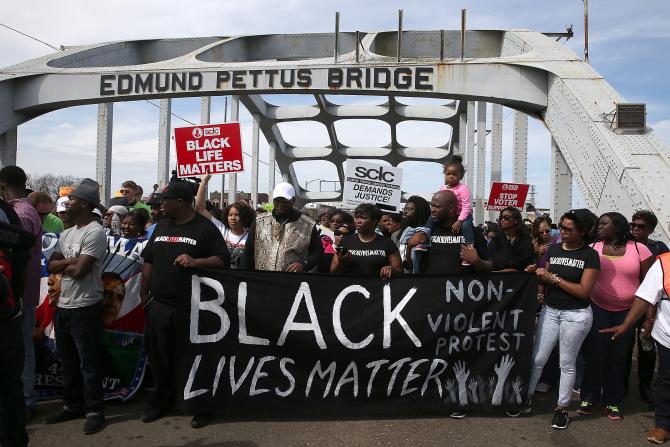‘Bloody Sunday’ Anniversary Commemorated With March Across Selma Bridge
Share
Explore Our Galleries
Breaking News!
Today's news and culture by Black and other reporters in the Black and mainstream media.
Ways to Support ABHM?
By Tami Chapelle, Reuters News Service
SELMA, Ala., March 8 (Reuters) – Tens of thousands of people paraded across a Selma, Alabama bridge on Sunday to commemorate the 1965 “Bloody Sunday” march, not waiting for dignitaries who had planned to lead them in marking the 50th anniversary of a turning point in the U.S. civil rights movement.
In contrast to the police violence that marked the original march half a century ago, the mood was often celebratory, at times festive, as an estimated 70,000 demonstrators cheered, sang “We Shall Overcome” and carried signs as they walked across the Edmund Pettus Bridge.
Bloody Sunday on March 7, 1965, took its name from the beating that roughly 600 peaceful civil rights activists sustained at the hands of white state troopers and police who attacked them with batons and sprayed them with tear gas…
A large throng of people started walking across the bridge at the appointed time, before dignitaries could be brought to the front to lead them.
Among the throng were demonstrators who took part in the 1965 march, as well as others calling for immigration and gay rights.
President Barack Obama visited Selma on Saturday and declared the work of the U.S. civil rights movement advanced but unfinished in the face of ongoing racial tensions.
“Fifty years from Bloody Sunday, our march is not yet finished, but we’re getting closer,” said Obama, the first black president of the United States.
The anniversary comes at a time of renewed focus on racial disparities in the United States and anger over the treatment of black civilians, among them 18-year-old Michael Brown, whose killing by a white police officer in Ferguson, Missouri, last year sparked widespread protests…
Read the full article here.
Read more Breaking News here.












Comments Are Welcome
Note: We moderate submissions in order to create a space for meaningful dialogue, a space where museum visitors – adults and youth –– can exchange informed, thoughtful, and relevant comments that add value to our exhibits.
Racial slurs, personal attacks, obscenity, profanity, and SHOUTING do not meet the above standard. Such comments are posted in the exhibit Hateful Speech. Commercial promotions, impersonations, and incoherent comments likewise fail to meet our goals, so will not be posted. Submissions longer than 120 words will be shortened.
See our full Comments Policy here.